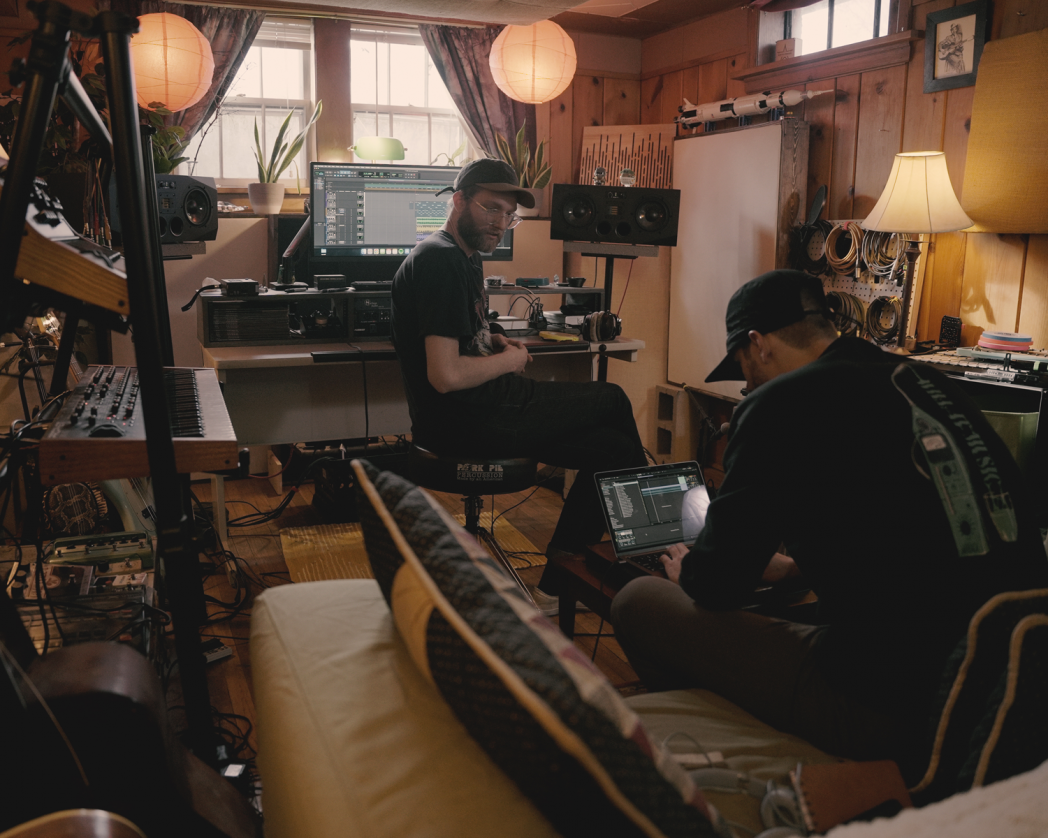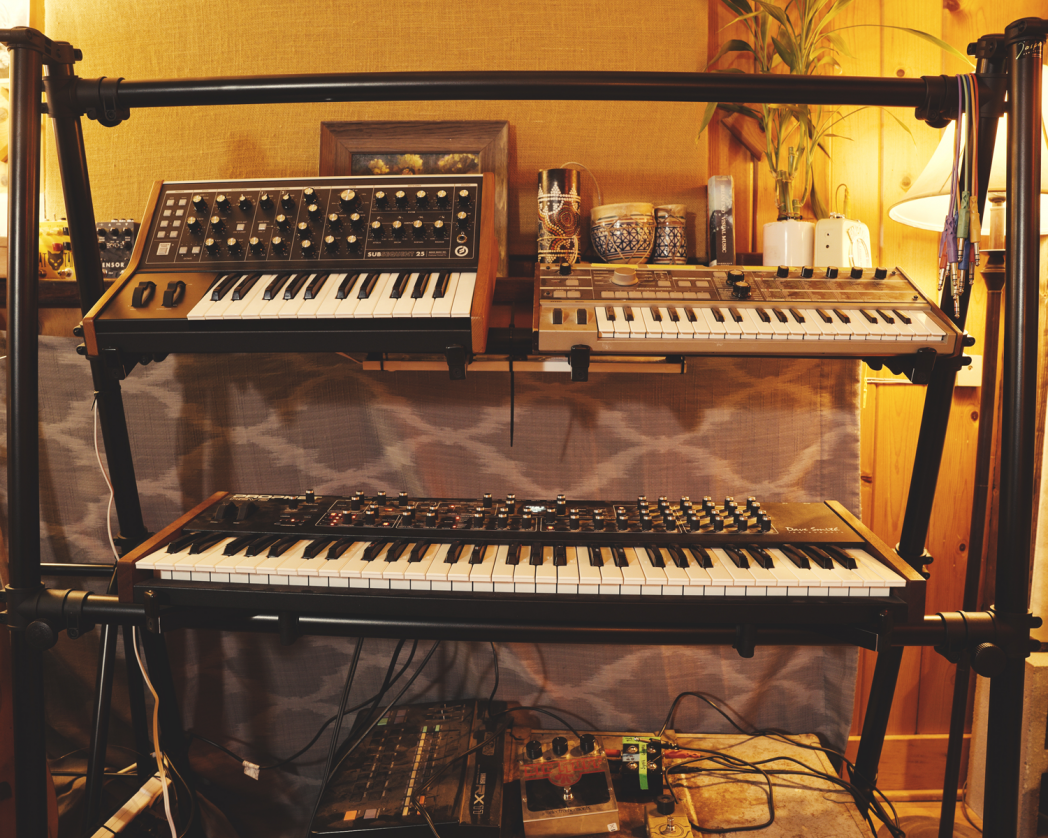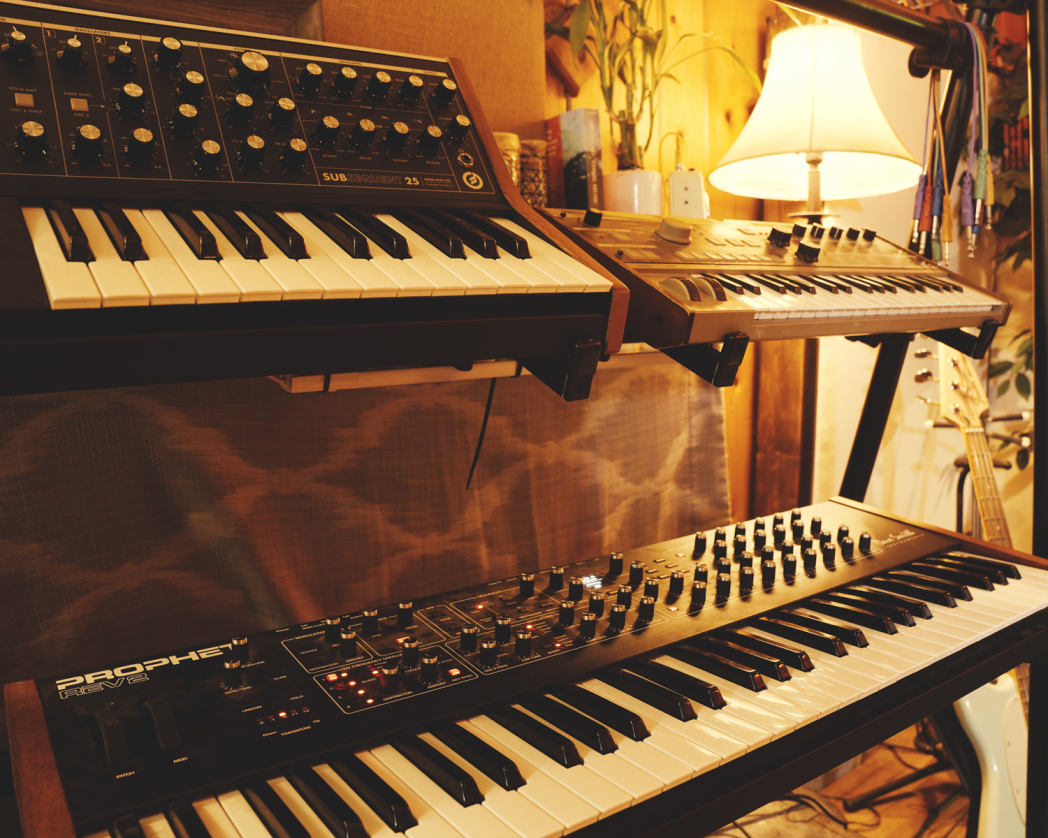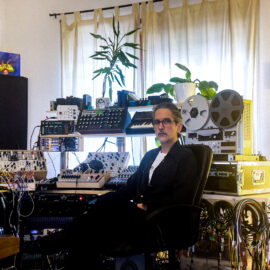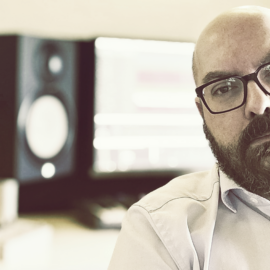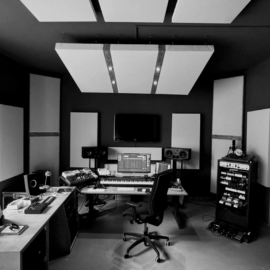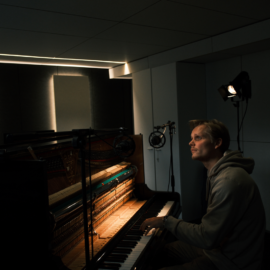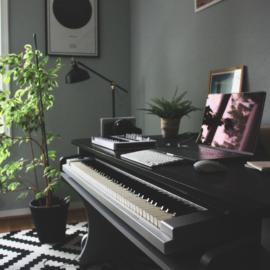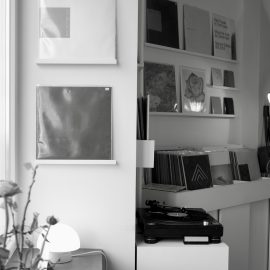Let’s start at the very beginning. Can you tell us how you got involved in composing, and what was your very first piece of gear?
When I was 15 years old, I was in a pretty terrible snowboarding accident. I broke my left shoulder and needed surgery, so I was laid up for several months without much activity. One day I picked up my little brother’s 3/4 scale nylon string guitar and started playing around with simple chord shapes and note combinations. Because I had very limited mobility on my left side, I would strum and fingerpick on the neck of the guitar instead of over the sound hole. I was immediately obsessed! As my bones healed, I progressed on the instrument, and my parents bought me my first full-scale guitar for my birthday. I always loved music growing up, so I was excited to learn my favorite songs, which quickly turned into creating my own little compositions. Through high school and into college, I played in several bands and eventually transitioned to playing the drums as my main focus. Playing in bands was rewarding in its own right, but I always wanted more autonomy in music. I eventually purchased my first audio interface and DAW (MBox 2 and ProTools 8), and I was off to the races! The creative possibilities were seemingly endless, and it really pushed me to develop my skills as a producer and composer. It allowed me to create my own little worlds and soundscapes.
How many different studio iterations have you gone through, and what does your final setup look like right now?
My studio is in constant flux! I think part of striving to be a better producer and composer is adapting your studio to maximize creative ideas. This will look a little different for everyone, but to me, it means being comfortable and having creative tools at arm’s reach. Currently, my setup is quite simple but effective: I have a Jaspers synth rack on my left with a Prophet Rev2, Moog Subsequent 25, and various pedals and effects to play around with. I use a Neve-style mic pre (HA-73) as my main preamp, which is quite versatile. I can get super clean tones or really distorted crunchy tones if I drive the input transformer. On my right is a wall of cabling organized on a pegboard and various bins of percussion, noisemakers, and hand drums. Having all these things on either side of me allows me to quickly get sounds and ideas down without much technical fuss.
Tell us about your favourite piece of hardware.
My absolute favorite piece of hardware is my Yamaha VSS-30. It’s a little 8-bit toy sampler from the 1980s, and it sounds so strange and cool! The only problem is that it’s so old that it only works when it wants to! I first became aware of the sampler by listening to interviews with artists like Sigur Ros, Jonsi, and Alex Somers. There’s this sort of beautiful lofi texture on many of their records. It’s gritty yet angelic at the same time. I just love the sound, and I use it whenever I think it might fit into the mix of a track.
And what about the software that you use for production?
My primary DAW is Pro Tools, mainly because I’ve become so fluent in it over the years. I recently got Ableton, though, and I’m trying to dip my toe in it, but the layout is a completely different world than I’m used to. It’s quite intimidating, but I know the creative possibilities for writing, sketching, and performing are unmatched. So I think eventually switching over (at least for writing) will be worth the trouble. I’m still in the very beginning stages of that process.
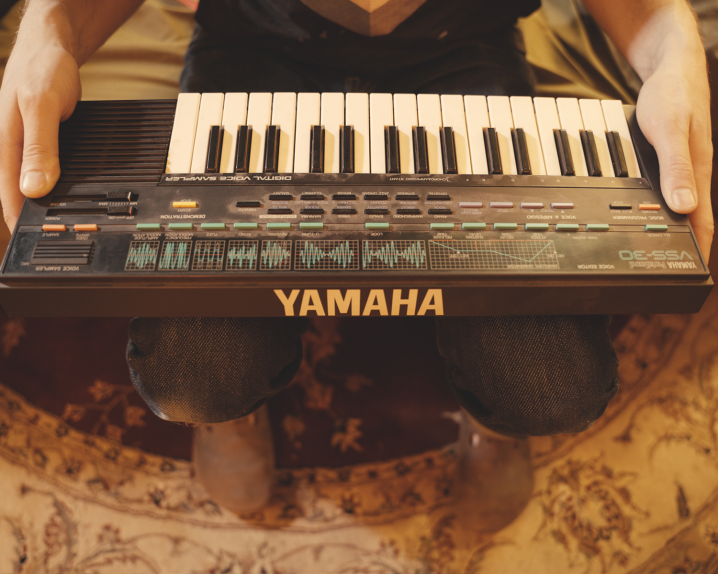
Is there a particular piece of gear that you’re just dying to get your hands on, and do you think one day you’ll have it?
I’ve always wanted a Space Echo, and seeing the Echo Fix’s modern take on it looks really impressive and much easier to maintain than the old Space Echos. So I’d say an EF-X2 would be a dream to try out! Another piece of kit that looks really exciting to me is the new Heritage Audio Tubesessor. It’s a tube-driven optical compressor based on Tube-Tech CL 1B compressor. The Tubesessor has varying options for tube saturation as well as variable attack/release settings, so it can be snappier than a traditional optical compressor if you want it to be. Two of them on a mix bus would be a dream, or even individually on vocals and bass elements… I’d love to own either of these pieces, but they’re quite expensive, so we’ll see how the next few years shake out for me, haha!
Can you please share some aspects of sound design in your work?
It changes from project to project but often starts with experimentation. Recording improvisations on an instrument and scrubbing through to find an interesting idea or moment. Then building a world around that single idea, even if it’s only a few notes. I find not being too precious is a real asset in sound design, and I like to work quickly and destructively. I believe this workflow often yields beautiful and unexpected results when you really focus on using these happy accidents as building blocks.
Any particular new techniques that you tried out for your new album?
My friend John Hays and I have a new ambient project coming out this spring called Twinsleep! We put out an LP in 2020 (Borealis), which was really uptempo and beat-oriented, and Twinsleep is a step in a completely different direction. Though I love working in both genres, this new album has allowed me a lot of sonic freedom. I used more of a stream-of-consciousness approach on the record, and I wasn’t as concerned with technical aspects. It allowed me to be expressive in a different way. We started this project right in the thick of the pandemic, so it felt therapeutic and self-soothing to create these mellow ambient sonic textures. One technique I used a lot was sampling my voice with the VSS-30 and adjusting the envelope to be really slow and drawn out. The sampler has a looper function built right in, so I’d make these eerie choir pads with my own “oohs” and “ahhs” that swell and decay like waves. Another thing I’d do is take a piano or organ track that John (Hayes) sent me, and I’d slow it way down, building drones around his performances. I also used lots of cassette dictaphones on the new record for degraded sound textures to weave into the mix.
What does your live setup look like, and what do you bring with you when you travel for an extensive tour?
I’ve become mainly a studio rat these days, but one of my goals in the next few years is to get enough of a grasp on Ableton to flesh out a live set. Making music in solitude is rewarding, but it can also be lonely. I’d like to take these sounds out into the real world and into my own community. It would be nice for the songs to exist outside of streaming platforms exclusively.
What is the most important environmental aspect of your current workspace, and what would be a particular element that you would improve on?
I think everyone does what works best for them, but it’s always been super important to me to feel comfortable in my creative space. I’d put comfort and “vibe” above gear in terms of importance with my creative flow. I like to have plants and random toys, and Lego sets around! I suppose it just reminds me that music is supposed to be playful and fun. I also live near a beautiful wilderness and recreation area in Missoula, Montana. This is where I go to clear my head or to just get out of the studio for a few. The landscape around here is awe-inspiring, so I try to get out of the studio whenever I can. I think taking breaks actually helps my creativity in the long run. I definitely need to get out in the sun more!
What can you tell us about your overall process of composition? How are the ideas born, where do they mature, and when do they finally see the light?
Experimentation is key! A spark might happen from using a piece of gear or a software plugin in an unconventional way. If I’m in a good creative flow state, I roll with it for as long as I can until I lose perspective on what I’m doing. Then I’ll circle back the next day or the next week to see if it still holds up for me emotionally. If the idea still piques my interest and I still have a strong emotional response to it, I’ll move forward to the next phase of the process. This next phase is more technical as I’m fleshing out the arrangement and dialling in the mix. The track will finally see the light when I feel like I can’t make any more changes within my abilities to make it better. I find that stripping elements away usually reveals something to me. I believe the essence of the track will present itself naturally through this workflow.
After the piece is complete, how do you audition the results? What are your reactions to hearing your music in a different context, setting, or a sound system?
I think referencing multiple sources is invaluable. It’s sort of a good “reality check” for me to hear my music in less-than-ideal situations. I generally use basic wired apple headphones to check mixes as well as references in my car. I’ll also send mixes to musician friends and producers to get constructive feedback on a track. It always helps to have an extra pair of ears!
Do you ever procrastinate? If so, what do you usually find yourself doing during those times?
I find myself procrastinating when I’m working on my own music. If there’s no deadline, it’s easy to push things off. That’s why I enjoy collaborating with other artists. I think I benefit from the accountability aspect of collaboration. Showing up for someone else really gets me fired up to put in hard work to finish a project in a timely manner.
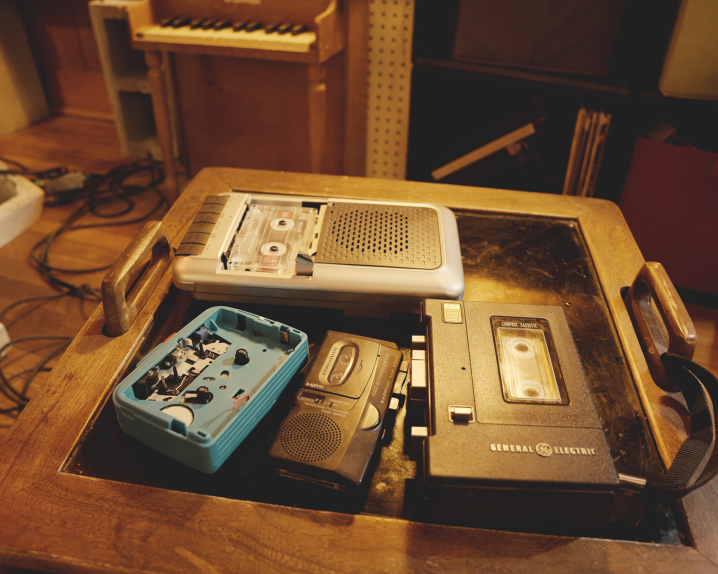
What gets you inspired?
Friends, family, movies, nature, photography. This list goes on!
And finally, what are your thoughts on the state of “electronic music” today?
I think electronic music (and music in general) is in a beautiful state right now. The barriers to entry are so low now that just about anyone can express themselves through sound. Resources for learning are plentiful, and the internet makes collaborating easier than ever. It’s all a beautiful thing, and I’m happy to be a part of it!
